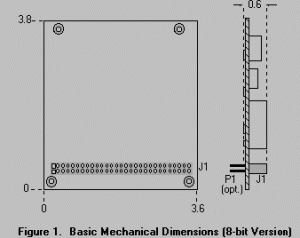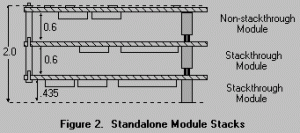What is PC/104?
The original PC/104 standard was oriented around the ISA bus (per IEEE P996), as used in early “personal computers”. This format pioneered the concept of stacking expansion.
Unlike the larger PC motherboards, the PC/104 format features:
- Compact form-factor. Only 3.6 by 3.8 inches.
- Self-stacking bus. Eliminates the cost and bulk of backplanes and card cages for expansion.
- Pin-and-socket connectors. Rugged and reliable pin headers replaced the PC’s edge-card connectors.
By virtue of the PC/104 format, companies embedding PC technology in limited space applications were able to benefit from a standardized architecture with a wide range of functions and multi-vendor support.
Using PC/104 Modules
As shown in Figure 2, PC/104 modules are self-stacking. In this approach, the modules mechanically and electrically interconnect without the use of backplanes or card cages. Stacked modules are spaced 0.6 inches apart, forming compact system stacks.
Our Legacy
The original stacking concept has given way to numerous newer and faster versions of PC/104, all of which feature quick stack-together system configuration, and outstanding ruggedness, using off-the-shelf products.
The original PC/104 format, and more so it’s sister format PC/104-Plus, are still manufactured and in use in slower speed systems that benefit from modularity and ruggedness.

